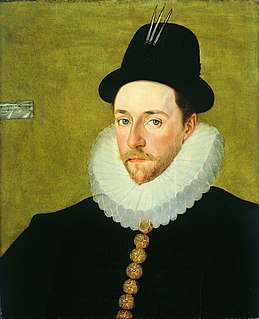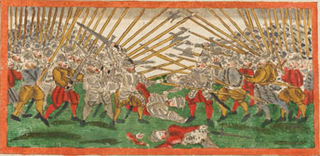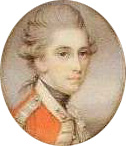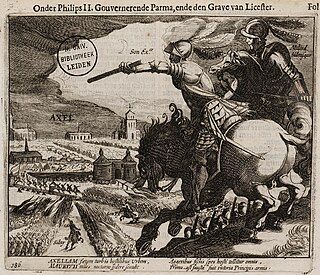
Earl of Lindsey is a title in the Peerage of England. It was created in 1626 for the 14th Baron Willoughby de Eresby. He was First Lord of the Admiralty from 1635 to 1636 and also established his claim in right of his mother to the hereditary office of Lord Great Chamberlain of England. Lord Lindsey fought on the Royalist side in the Civil War and was killed at the Battle of Edgehill on 23 October 1642. He was succeeded by his son, the second Earl. He also fought at Edgehill and surrendered to the Parliamentarians in order to attend his mortally wounded father. Lord Lindsey later fought at the First Battle of Newbury, Second Battle of Newbury, and at Naseby. His son from his second marriage, James, was created Earl of Abingdon in 1682. He was succeeded by his son from his first marriage to Martha Cockayne, the third Earl. He represented Boston in the House of Commons and served as Lord Lieutenant of Lincolnshire.

Baron Willoughby de Eresby is a title in the Peerage of England. It was created in 1313 for Robert de Willoughby. Since 1983, the title has been held by Jane Heathcote-Drummond-Willoughby, 28th Baroness Willoughby de Eresby.

Sir Roger Williams was a Welsh soldier of fortune and military theorist, who served the Protestant cause, fighting against the Spanish in several theatres of war. Robert Dudley, 1st Earl of Leicester said that as a soldier he was "worth his weight in gold". He was later a close associate of Robert Devereux, 2nd Earl of Essex, and became a national hero because of his exploits fighting the Catholic League. He has been described as "an obstreperous, opinionated Welsh soldier" who was "Essex's devoted confederate and agent".

Robert Bertie, 1st Duke of Ancaster and Kesteven PC, styled17th Baron Willoughby de Eresby between 1666 and 1701, and known as 4th Earl of Lindsey between 1701 and 1706, and as 1st Marquess of Lindsey between 1706 and 1715, was a British statesman and nobleman.

Peregrine Bertie, 2nd Duke of Ancaster and Kesteven, styled The Honourable Peregrine Bertie between 1686 and 1704, Lord Willoughby de Eresby between 1704 and 1715 and Marquess of Lindsey between 1715 and 1723, was a British politician who sat in the House of Commons from 1708 until 1715 when he was called to the House of Lords.

Katherine Brandon, Duchess of Suffolk, suo jure12th Baroness Willoughby de Eresby, was an English noblewoman living at the courts of King Henry VIII, King Edward VI and Queen Elizabeth I. She was the fourth wife of Charles Brandon, 1st Duke of Suffolk, who acted as her legal guardian during his third marriage to Henry VIII's sister Mary. Her second husband was Richard Bertie, a member of her household. Following Charles Brandon's death in 1545, it was rumoured that King Henry had considered marrying Katherine as his seventh wife, while he was still married to his sixth wife, Catherine Parr, who was Katherine's close friend.

General Peregrine Bertie, 3rd Duke of Ancaster and Kesteven, styled Lord Willoughby de Eresby from 1715 to 1723 and Marquess of Lindsey from 1735 to 1742 was the son of Peregrine Bertie, 2nd Duke of Ancaster and Kesteven.

Peregrine Bertie, 13th Baron Willoughby de Eresby was the son of Catherine Willoughby, 12th Baroness Willoughby de Eresby, and Richard Bertie. Bertie was Lady Willoughby de Eresby's second husband, the first being Charles Brandon, Duke of Suffolk. Peregrine Bertie's half-brothers, Henry and Charles Brandon, died as teenagers four years before his birth. His sister Susan married the Earl of Kent and then the nephew of Bess of Hardwick. Owing to religious politics, the parents had to move outside England and the boy was born at Wesel on the River Rhine.

The Battle of Zutphen was fought on 22 September 1586, near the village of Warnsveld and the town of Zutphen, the Netherlands, during the Eighty Years' War. It was fought between the forces of the United Provinces of the Netherlands, aided by the English, against the Spanish. In 1585, England signed the Treaty of Nonsuch with the States-General of the Netherlands and formally entered the war against Spain. Robert Dudley, Earl of Leicester, was appointed as the Governor-General of the Netherlands and sent there in command of an English army to support the Dutch rebels. When Alessandro Farnese, Duke of Parma and commander of the Spanish Army of Flanders, besieged the town of Rheinberg during the Cologne War, Leicester, in turn, besieged the town of Zutphen, in the province of Gelderland and on the eastern bank of the river IJssel.

Priscilla Barbara Elizabeth Bertie, 21st Baroness Willoughby de Eresby, known before 1780 as Lady Priscilla Bertie, was a daughter of the Peregrine Bertie, 3rd Duke of Ancaster and Kesteven, and Mary Panton. Through her grandmother Mary Wynn, Priscilla Bertie was a descendant of the Welsh princely house of Aberffraw.
Peter Robert Drummond-Burrell, 2nd Baron Gwydyr, 22nd Baron Willoughby de Eresby PC, was a British politician and nobleman.

Robert Bertie, 4th Duke of Ancaster and Kesteven, PC, styled Lord Robert Bertie until 1758 and Marquess of Lindsey between 1758 and 1778, was a British peer. He was born in Grimsthorpe, the second son of the General Peregrine Bertie, 3rd Duke of Ancaster and Kesteven and Mary Panton
Robert Bertie, 3rd Earl of Lindsey PC FRS, styled Lord Willoughby de Eresby from 1642 to 1666, was an English nobleman.
Peter Burrell, 1st Baron Gwydyr PC featured in English politics at the end of the 18th century, but he was best known for his involvement in cricket, particularly his part in the foundation of Marylebone Cricket Club in 1787.

The siege of Bergen op Zoom was a siege that took place during the Eighty Years' War and the Anglo–Spanish War between September 23 - November 13, 1588. The siege was between a besieged Anglo-Dutch force under Thomas Morgan and Peregrine Bertie and a Spanish besieging force under famed commander Alexander Farnese, the Duke of Parma. An English officer Grimstone claimed to be a disaffected Catholic, had set up a trap during which a large Spanish assault was then bloodily repulsed. An Anglo-Dutch relief column under the command Maurice of Orange soon after arrived and forced the Duke of Parma to retreat, thus ending the siege.

Richard Bertie was an English landowner and religious evangelical. He was the second husband of Catherine Willoughby, 12th Baroness Willoughby de Eresby, Duchess Dowager of Suffolk and a woman whom Henry VIII was considering as his seventh wife shortly before his death; she also received a proposal from the King of Poland.
Sir John Wingfield was an English soldier.
Mary de Vere was a 16th-century English noblewoman who lived a life of extraordinary wealth and privilege. The daughter of John de Vere, 16th Earl of Oxford, and his second wife Margery Golding, she married Peregrine Bertie, 13th Baron Willoughby de Eresby. The couple lived with their six children in Grimsthorpe Castle in Lincolnshire. Following Bertie's death, Lady Willoughby married Sir Eustace Hart. She died on about 24 June 1624.

The Capture of Axel was a military event during the Dutch Revolt and the Anglo–Spanish War in which the town of Axel, defended by the Spanish, was captured by an Anglo-Dutch force led by Sir Philip Sidney, with the garrison being put to the sword. It was also the first feat of Maurice of Nassau.

Mary Bertie, Duchess of Ancaster and Kesteven, formerly Mary Panton, was the second wife of Peregrine Bertie, 3rd Duke of Ancaster and Kesteven. She was the daughter of Thomas Panton of Newmarket (1697-1782), who was an equerry to King George II and master of the Thurlow Hunt, and his wife Priscilla.















